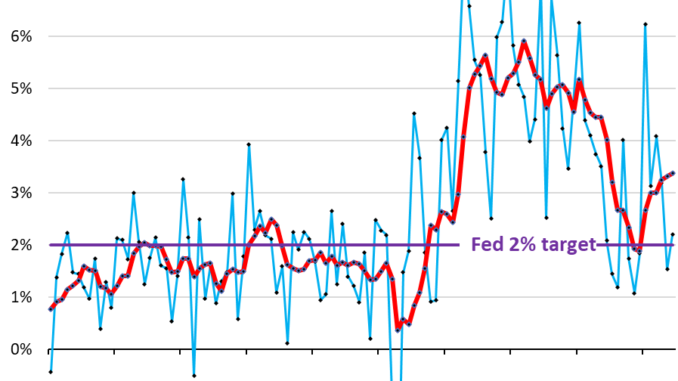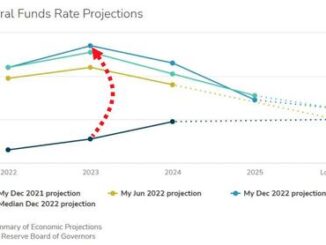
Powell has some explaining to do. Only slight concessions about strength of the labor market and improvements in inflation.
By Wolf Richter for WOLF STREET.
FOMC members voted unanimously today to maintain the Fed’s five policy rates, with the top of its policy rates at 5.50%, according to the statement released today after its two-day meeting. The last rate hike occurred in July 2023, and this decision marks the anniversary of the 5.25% to 5.5% rates:
Federal funds rate target range between 5.25% and 5.5%.
Interest it pays the banks on reserves: 5.4%.
Interest it pays on overnight Reverse Repos (ON RRPs): 5.3%.
Interest it charges on overnight Repos: 5.5%.
Interest it charges banks to borrow at the “Discount Window”: 5.5%.
No rate cut in July has been broadly telegraphed in speeches and interviews by Fed governors, and markets did not expect a cut at this meeting.
But 25-basis-point cut in September has been fully priced in by the markets. They expect with near 100% certainty a rate cut in September – not in December, not in November, but in September. In recent weeks, there has been no room for doubt about a cut in September.
Where the heck is the September rate cut?
The statement did not say anything about a rate cut in September and left the language concerning its policy rates unchanged. It will be up to Powell at the press conference to explain what is going on in here.
The statement repeated the language that it had used since January to push back against Rate-Cut Mania, for the fifth time:
“In considering any adjustments to the target range for the federal funds rate, the Committee will carefully assess incoming data, the evolving outlook, and the balance of risks.”
“The Committee does not expect it will be appropriate to reduce the target range until it has gained greater confidence that inflation is moving sustainably toward 2 percent.”
The statement repeated what it had said since the rate hikes started, to push back against voices that propagate raising the Fed’s inflation target to 3% or 4% or whatever.
“The Committee is strongly committed to returning inflation to its 2 percent objective.”
What changed in the statement:
The description of the labor market:
New: “Job gains have moderated, and the unemployment rate has moved up but remains low.”
Old: “Job gains have remained strong, and the unemployment rate has remained low.”
The description of inflation:
New: “Inflation has eased over the past year but remains somewhat elevated. In recent months, there has been some further progress toward the Committee’s 2 percent inflation objective.”
Old: “Inflation has eased over the past year but remains elevated. In recent months, there has been modest further progress toward the Committee’s 2 percent inflation objective.”
On the Fed’s employment and inflation goals:
New: “The Committee judges that the risks to achieving its employment and inflation goals continue to move into better balance. The economic outlook is uncertain, and the Committee is attentive to the risks to both sides of its dual mandate.”
Old: “The Committee judges that the risks to achieving its employment and inflation goals have moved toward better balance over the past year. The economic outlook is uncertain, and the Committee remains highly attentive to inflation risks.”
QT continues at the slower pace.
As was announced in May, the Treasury roll-off continues at $25 billion per month, and MBS come off without any cap – whatever comes off, comes off. But if more than $35 billion of MBS come off in a month, the overage is reinvested in Treasury securities.
The Fed has already shed $1.74 trillion in assets since it started QT in July 2022. To avoid the mess the Fed ran into with the repo market blowout in September 2019 after QT-1, it started slowing down the roll-off in June as per new plan. “By going slower, you can get farther,” Powell had said at the press conference after the May meeting. July is the second month of the slower pace.
It was a no-dot-plot meeting. Today was one of the four meetings a year when the Fed does not release a “Summary of Economic Projections” (SEP), which includes the infamous “dot plot” which shows how each FOMC member sees the development of future policy rates. SEP releases occur at meetings that are near the end of the quarter. The next SEP will be released after the September 17-18 meeting.
Here’s what Powell said at the press conference: How Powell Kept a September Rate Cut up in the Air.
The whole statement:
Recent indicators suggest that economic activity has continued to expand at a solid pace. Job gains have moderated, and the unemployment rate has moved up but remains low. Inflation has eased over the past year but remains somewhat elevated. In recent months, there has been some further progress toward the Committee’s 2 percent inflation objective.
The Committee seeks to achieve maximum employment and inflation at the rate of 2 percent over the longer run. The Committee judges that the risks to achieving its employment and inflation goals continue to move into better balance. The economic outlook is uncertain, and the Committee is attentive to the risks to both sides of its dual mandate.
In support of its goals, the Committee decided to maintain the target range for the federal funds rate at 5-1/4 to 5-1/2 percent. In considering any adjustments to the target range for the federal funds rate, the Committee will carefully assess incoming data, the evolving outlook, and the balance of risks. The Committee does not expect it will be appropriate to reduce the target range until it has gained greater confidence that inflation is moving sustainably toward 2 percent. In addition, the Committee will continue reducing its holdings of Treasury securities and agency debt and agency mortgage‑backed securities. The Committee is strongly committed to returning inflation to its 2 percent objective.
In assessing the appropriate stance of monetary policy, the Committee will continue to monitor the implications of incoming information for the economic outlook. The Committee would be prepared to adjust the stance of monetary policy as appropriate if risks emerge that could impede the attainment of the Committee’s goals. The Committee’s assessments will take into account a wide range of information, including readings on labor market conditions, inflation pressures and inflation expectations, and financial and international developments.
Voting for the monetary policy action were Jerome H. Powell, Chair; John C. Williams, Vice Chair; Thomas I. Barkin; Michael S. Barr; Raphael W. Bostic; Michelle W. Bowman; Lisa D. Cook; Mary C. Daly; Austan D. Goolsbee; Philip N. Jefferson; Adriana D. Kugler; and Christopher J. Waller. Austan D. Goolsbee voted as an alternate member at this meeting.
Enjoy reading WOLF STREET and want to support it? You can donate. I appreciate it immensely. Click on the beer and iced-tea mug to find out how:
Would you like to be notified via email when WOLF STREET publishes a new article? Sign up here.
Take the Survey at https://survey.energynewsbeat.com/






